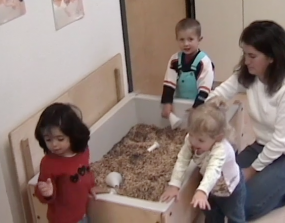Fly, Fly, Go Away

Teachers often struggle to explain the value of play for young children’s learning and development. Play provides an important opportunity for the teacher to learn about the interests of the children. The teacher is then better able to become an effective play partner, building on the children’s prior knowledge in order to extend learning. In addition, play provides an opportunity for children to experience a sense of competence and control as they make decisions and work to coordinate their play with peers.
This Thinkprint shows how young children collaboratively transform an unexpected event - the presence of a housefly inside their classroom - into an exciting invented social game. Watch as one of the children notices the housefly and announces its presence with great excitement. Learn more about the children’s literacy development as a nearby child quickly adapts a familiar refrain (Fly, fly, go away!) to frame this unexpected event. See how one child initiates a spontaneous game by posing an invitation for another child to join her in pursuit of the fly. Then notice how she skillfully ensures her friend’s participation by slowing down and looking back to encourage her to join in the chase. A squeal signals a fleeting encounter with the housefly, and the child demonstrates her knowledge about others’ perspectives by pausing to explain “There’s a fly”. From across the classroom, another child invents a clever strategy for gaining entry into the social game. Watch how he exhibits heightened enthusiasm by projecting his voice and by stretching his arms high above his head as he alerts the girls to the location of the fly.
In this Thinkprint we see how spontaneous play allows these young children to constitute their social competence. We are invited to consider what “likely thoughts” may guide the children’s ability to successfully tune in to one another, to take turns leading and following, to demonstrate mutual concern, and to maintain levels of excitement and involvement as they experience shared joy.
Keywords: Twos, Body, Child-Child, Maintaining Play, Obstacle, Thinkprint
Length of Thinkprint: 22 paragraphs, 19 video subclips
